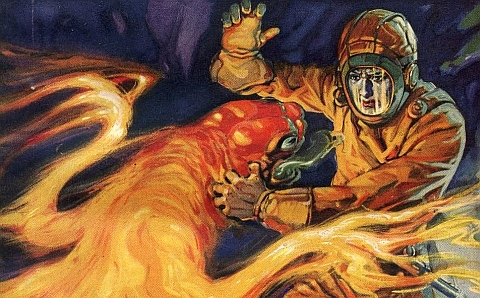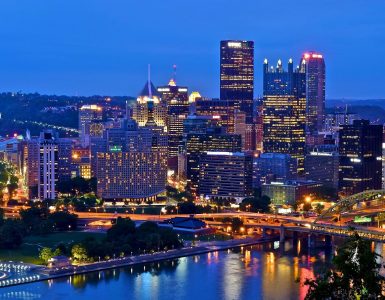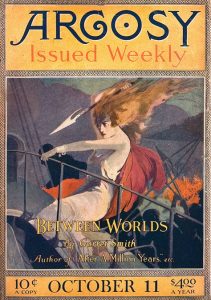 On Friday, July 23, at 7:50 PM, one of PulpFest‘s most popular presenters, artist and art historian David Saunders, returns to our programming stage in the Union Rooms on the second floor of the Hyatt Regency Columbus for a look at “The Artists Who Make ARGOSY.”
On Friday, July 23, at 7:50 PM, one of PulpFest‘s most popular presenters, artist and art historian David Saunders, returns to our programming stage in the Union Rooms on the second floor of the Hyatt Regency Columbus for a look at “The Artists Who Make ARGOSY.”
The first all-fiction pulp magazine, THE ARGOSY was founded as a children’s weekly by publisher Frank A. Munsey in 1882. Originally titled THE GOLDEN ARGOSY, it was converted to a general fiction pulp magazine with its December 1896 number. Within ten years, it was selling a half million copies of each issue. Through numerous title and format variations, as well as editorial and publisher changes, the magazine soldiered on for nearly a century, its final number dated November 1979. As a pulp, it lasted for over 1500 issues and nearly fifty years. Following its August 1943 number, it was converted to the slick format, reduced its fiction content, and eventually became a men’s adventure magazine.
Today, ARGOSY is sought after for its authors and its series characters. H. Bedford-Jones, Max Brand (Frederick Faust), Edgar Rice Burroughs, Ellis Parker Butler, Borden Chase, Walt Coburn, Ray Cummings, Norbert Davis, Lester Dent, Ralph Milne Farley, C. S. Forester, Erle Stanley Gardner, Zane Grey, L. Patrick Greene, O. Henry, Robert E. Howard, L. Ron Hubbard, Otis Adelbert Kline, Harold Lamb, Murray Leinster, Gordon MacCreagh, Johnston McCulley, Fred MacIsaac, A. Merritt, Clarence E. Mulford, Hugh Pendexter, Mary Roberts Rinehart, Theodore Roscoe, Charles Alden Seltzer, Perley Poore Sheehan, Upton Sinclair, Francis Stevens, W. C. Tuttle, W. Wirt, Cornell Woolrich, George F. Worts, and countless other talented writers found a home in its rough-paper pages. Popular series characters featured in the magazine included Captain Horatio Hornblower, Carson Napier, Dr. Kildare, Gillian Hazeltine, Hopalong Cassiday, Jan of the Jungle, Jimmie Cordie, John Carter, John Solomon, Madame Storey, Montana Kid, Peter the Brazen, Semi Dual, Sheriff Henry, Singapore Sammy, Tarzan, Thibaut Corday, Zorro, and many others.
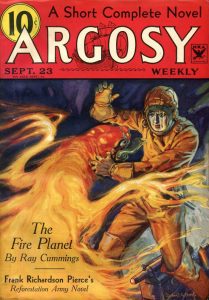 But what about the days when ARGOSY was being read by hundreds of thousands of men, women, and children? Although a favorite writer or character was enough to convince a regular ARGOSY reader to part with his or her hard-earned money at the newsstand, it was often a pulp magazine’s artwork that reeled in the new or the casual reader. Like every great pulp magazine, ARGOSY employed some of the best artists in the business: Rudolph Belarski, Ernest Chiriacka, Rafael M. DeSoto, Charles Dye, Marshall Frantz, Robert A. Graef, P. J. Monahan, Roger B. Morrison, Stockton Mulford, John R. Neill, Clinton Pettee, Norman Rockwell, Norman Saunders, Fred W. Small, Paul Stahr, Peter Stevens, Emmett Watson, and others.
But what about the days when ARGOSY was being read by hundreds of thousands of men, women, and children? Although a favorite writer or character was enough to convince a regular ARGOSY reader to part with his or her hard-earned money at the newsstand, it was often a pulp magazine’s artwork that reeled in the new or the casual reader. Like every great pulp magazine, ARGOSY employed some of the best artists in the business: Rudolph Belarski, Ernest Chiriacka, Rafael M. DeSoto, Charles Dye, Marshall Frantz, Robert A. Graef, P. J. Monahan, Roger B. Morrison, Stockton Mulford, John R. Neill, Clinton Pettee, Norman Rockwell, Norman Saunders, Fred W. Small, Paul Stahr, Peter Stevens, Emmett Watson, and others.
Join David Saunders at PulpFest 2016 for a survey of ARGOSY covers and story illustrations, plus rarely seen original cover paintings and drawings, as well as rare photographs of many of the “Artists Who Make ARGOSY,” part of this year’s celebration of the 120th anniversary of the first pulp magazine — THE ARGOSY.
Born in 1954, David Saunders is a New York artist. His work has been collected worldwide and can be found in the Museum of Modern Art, The Metropolitan Museum of Art, The Brooklyn Museum of Art, and the Hirschhorn Museum of Art in Washington, DC. He has taught art at Yale, Oberlin, and the Kansas City Art Institute, as well as art schools in France, Korea, Mexico and Japan.
David’s father was the legendary illustrator, Norman Saunders. His mother, Ellene Politis Saunders, worked at Fawcett Publications as Chief Executive Editor for WOMAN’S DAY. In 1972, David became his father’s business secretary, which started a long project to catalog his father’s 7,000 published illustrations. He spent the next seventeen years gathering published examples of his father’s work from used bookshops and submitting each new entry to his father’s inspection. What began as a sentimental hobby for a father and son grew into an impressive archive of 20th century American illustration. After his father’s death in 1989, he completed the archive on his own. He interviewed his father’s surviving associates to record their oral histories. These transcripts helped to broaden his viewpoint of the popular culture publishing industry and also documented vital information about the lives of other artists. Some of this material has been published as biographical profiles in ILLUSTRATION MAGAZINE and several coffee-table art books on pulp artists.
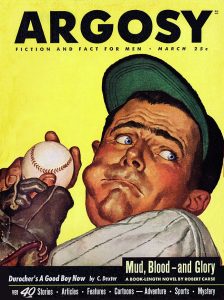 David is, quite probably, the foremost scholar of American pulp illustrators. His free public website, Field Guide to Wild American Pulp Artists, has over three-hundred biographical profiles of these creators of popular culture. David continues to research, document, and promote a greater appreciation of pulp artists. To find out more, please visit davidsaunders.biz, normansaunders.com, and theillustratedpress.com.
David is, quite probably, the foremost scholar of American pulp illustrators. His free public website, Field Guide to Wild American Pulp Artists, has over three-hundred biographical profiles of these creators of popular culture. David continues to research, document, and promote a greater appreciation of pulp artists. To find out more, please visit davidsaunders.biz, normansaunders.com, and theillustratedpress.com.
After checking out David’s credentials, be sure to get ready to attend “Summer’s AMAZING Pulp Con” as we salute the 120th anniversary of the birth of the pulp magazine from July 21 through July 24 in the Columbus, Ohio Arena district at the Hyatt Regency hotel and the city’s spacious convention center. “You’ll be in for a great adventure” at PulpFest, the pop culture center of the universe.
(Over its years as a pulp and later a men’s adventure magazine, ARGOSY was the full package: good authors, good stories, and good art.
Born in San Francisco, Fred W. Small moved to New York City in 1910. Within two years, he was working exclusively for the Munsey magazines, contributing covers and interior art to THE ALL-STORY, ARGOSY — including the October 11, 1919 issue — CAVALIER, and MUNSEY’S MAGAZINE. His last pulp magazine illustrations appeared in 1921.
Robert A. Graef studied art at the Pratt Institute of Brooklyn. Soon after graduation, he began illustrating for a variety of magazines and newspapers. During the First World War, he contributed patriotic recruitment posters to the war effort. He added pulp magazines to his markets during the mid-twenties, most notably ARGOSY — including the September 23, 1933 number. Over the years, he contributed a great deal of art to the Munsey magazine and other pulps.
During its early years as a slick, ARGOSY employed painted covers, including the March 1947 number with cover art by Charles Dye. The artist contributed many interior story illustrations and covers to Popular Publications’ western pulp magazines as well as ADVENTURE and ARGOSY. He later contributed the same to the men’s adventure market.
Good authors, good stories, and good art made ARGOSY a great magazine. Witness the nearly forty years of covers illustrated above.)

